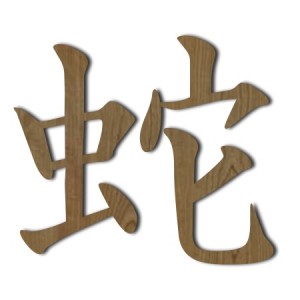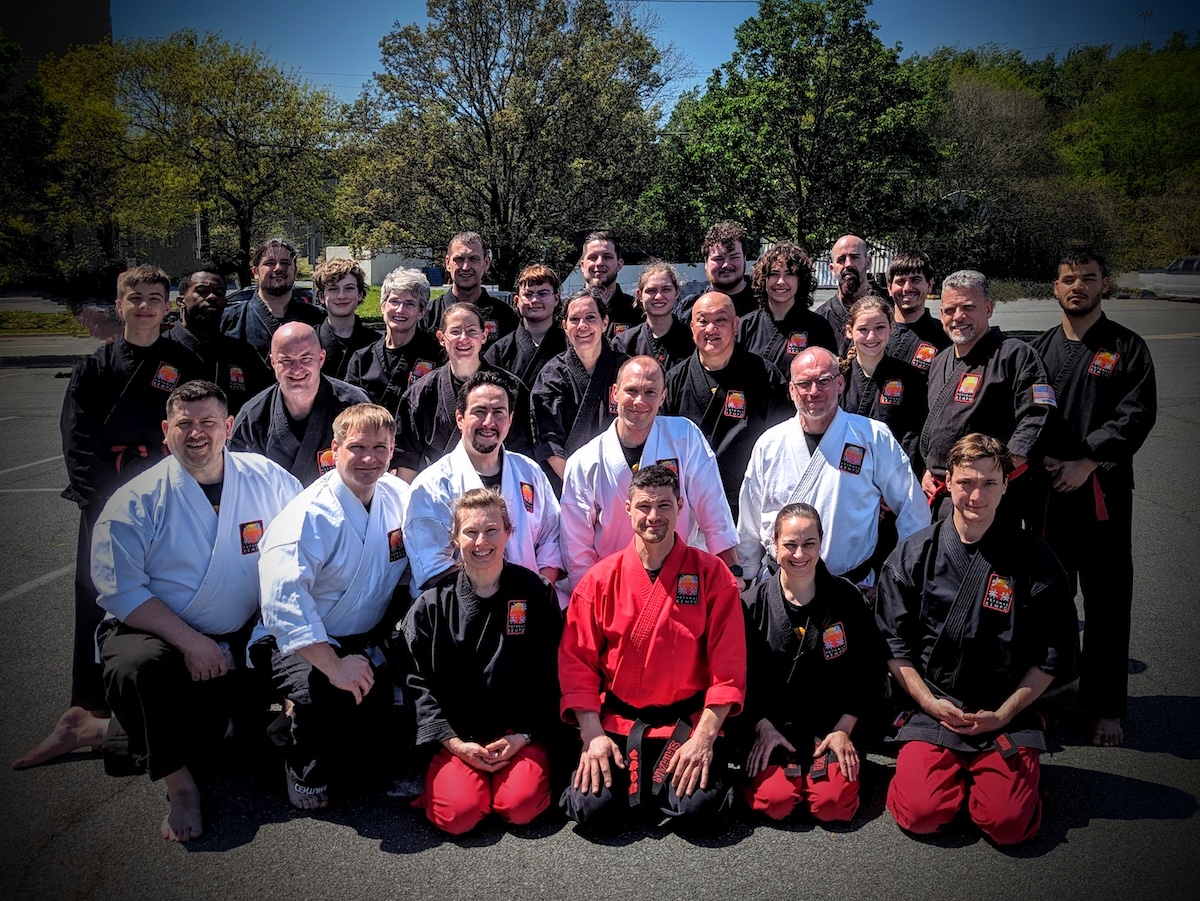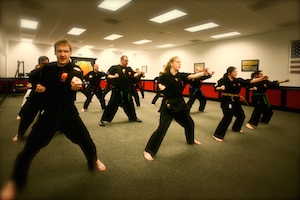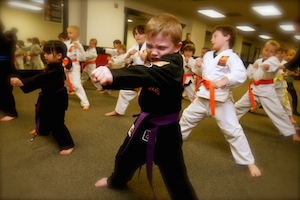Throughout Chinese history we see stories of the Snake. If we look, we find the Snake revered from many quarters. Sun Tzu, in his work Art of War, used a Snake that could attack with both head and tail as a simile for a skilled general who could do the same. Even before Buddha lived, Snakes were the subject of stories and fascination. In the Chinese Zodiac, started more than 5000 years ago, the Snake has a prominent role. Entwined through all of this is the Snake’s use as an icon for Qi development — a symbol of the cultivation of inner strength.
There is a story that tells of a Buddhist monk splitting wood at the door of the room where monks took hot baths. A Snake had been resting in the pile of wood and was woken by the monk. The Snake proceeded to bite the monk on his big toe and the monk died on the spot. The news of his death spread through the monastery, even to the Hall of Truth. The Teacher inquired what the monks were going on about and they told him. The teacher replied, “If that monk had cultivated friendship for the four royal families of Snakes, the Snake would not have bitten him.”
From another distant point in history we learn that the twelve animals of the Chinese Zodiac gained their places by competing in a race across a great river. The Snake, though largely discounted because of his size used strategy, resilience, and cunning to secure his place. He secretly held on to the hoof of the Horse to gain a ride across the river, and at the last moment scared the Horse to edge him out for sixth place.
Fighting Style
There are two aspects to Snake fighting methodology; they differ greatly but compliment each other nicely. One is derived from the Python, and it entwines, locks, and chokes. The other is derived from the Cobra, and it uses lightning quick strikes to vitals and pressure points. The composite style will mix these two tactics to great effect.
Once an attack is intercepted, the Snake will employ either or both of the tactics described above. In some cases he will favor his Cobra tactics and focus on striking quickly to vital areas. This will often be done by moving laterally to block and then quickly following the attacking limb to its source, all the while maintaining contact. This could take the form of a punch being deflected with the forearm, followed by a spear-hand to the throat while maintaining constant pressure on the attackers arm. This contact, called Bridging, allows the Snake to be continually aware of even the slightest movement that his opponent takes, and prevents the initial strike from being redeployed to another area.
Alternately, the Snake may choose to favor his Python tactics. He will block in the same manner, then Bridge and follow the attacking limb, but then will entwine the opponent. This entwining could be a lock, a choke, or something as simple as wrapping the arm. At the moment of the first contact and the Bridge that is formed there, the Snake will be able to feel his opponent’s movements. As he entwines, the Snake will begin to control his opponent’s every move.
Just as often, the Snake will employ a hybrid of tactics. He will deflect strikes and then entwine and strike to vitals, often locking up one of his opponent’s limbs and striking in such a way that his opponent’s inevitable recoil from his strike tightens the lock even more. With each successive strike the lock becomes more controlling and with each tightening of the lock the strikes become easier to land. It is interesting to note that the Bridge is used for both Snake tactics as well as their hybrid. The Bridge can then be seen as the unifying aspect of the Snake dichotomy.
The Snake will often choose his tactic based on his opponent’s relative size. Entwining and locking works best when the Snake has a size advantage, or at least size parity. Striking quickly to vitals works best when the Snake has a speed advantage — something he very much hopes to have if he lacks a size advantage.
As the Snake becomes more advanced, there is less and less distinction between his block and his follow up movement. At the highest level the Snake is able to make contact with his opponent’s striking limb in such a way that he deflects it without deviating from his own attack. He will make contact — form the Bridge — deflect the attack and continue on to strike a vital point — or lock — at his option.
Striking and Blocking
As discussed, the Snake will block and then maintain contact with the attacking limb for his follow-up movement, rather than recoil from it and initiate a new movement as most animals would. He will not drive through the attack as a Tiger might, but instead will deflect it only as much as is necessary and then rotate around the opponent’s limb in order to strike his target or entwine him.
As much as is possible the Snake will disassociate his body from his arm movements. He favors soft deflections so that he needn’t commit his body to each block. Likewise, pinpoint strikes to vitals and pressure points do not require the same amount of power that more basic attacks would. In this way, by working predominantly from the arms he can strike very quickly and repeatedly.
The most common Snake strike is the Spear-Hand, or as it is sometimes called, the Snake Hand — striking forward with the tips of all fingers. The Snake will also use the tips of the first two fingers, to make an Immortal Man or Snake Tongue strike. To attack the eyes the Snake will use the first two fingers separated, a Two Finger Poke. Similar, but more powerful, a Snake Tooth is formed with the first two fingers together and the third and fourth fingers together. The only common Snake strike that is not linear is the Snake Bite, executed by forming the tips of the thumb and first two fingers together and whipping from the wrist.
The Snake will invariably keep to low kicks, whipping quickly and striking to the knee, inner thigh and groin. Although he will also employ more traditional kicks that strike with the ball of the foot, the instep and shin, he favors striking with the toes to pinpoint his kicks to particularly vulnerable areas.
Three Treasures — Qi
The Snake is the embodiment of Qi cultivation, acting as a model of internal energy and strength development. Qi is the most well known — and arguably the most important — of the Three Treasures. It is the spirit energy that flows through our bodies and suffuses our lives. When our body lacks the strength we need, we draw on our Qi. When our mind lacks focus and clarity, we draw on our Qi.
In a very real sense the strength of our Qi affects the success of everything we do. The Snake demonstrates the value of Qi through allegory, and demonstrates how to cultivate it. The Snake is the most unlikely of creatures, possessing neither arms nor legs; neither talons nor wings. Yet he is as successful in life as any creature on Earth. The Snake has cultivated a strong connection to Qi in order to overcome his handicaps. In doing so, he demonstrates vividly the power of spirit and the importance of internal strength.
Furthermore, the movements of the Snake are well oriented to develop Qi. The Snake’s fluid and relaxed movement coupled with his penchant for slow and peaceful breathing is perfect for Qi cultivation. Insofar as we are the Snake we not only benefit from his strength, we develop it through practice. It is through this lens that we see the Snake as representing the idea of Overcoming Adversity.
In Relation to the Shaolin Animals
The Snake, when confronted with any opponent, will endeavor to close distance so that he might deploy repeated strikes or entwine. The Crane is very practiced at avoiding this tactic. The Crane will evade each attempt to close distance and strike back with superior range. If the Snake is able to close more, the Crane will reestablish distance with one of her ‘wings’ or her knee. If the Snake succeeds in entwining her, she will attack his vital points — which she favors every bit as much as he does — until the hold is loosened sufficiently to reestablish distance. At this point she will continue to peck away at the Snake wearing him down by degrees.
The Leopard takes its advantage from speed and lateral movement, making it hard to pin down. But pinning down is what the Snake does best. When the Leopard attacks initially it will invariably succeed in striking the Snake at least once. Unfailingly, the Snake will take one or more strikes at the outset but will consider that more than fair trade for entwining his foe. With its lateral mobility impaired by the Snake’s hold, the Leopard is without advantage. From there, the Snake will overcome it easily.
If a Snake were to face another Snake, the confrontation would unfold very quickly. They would both close distance and both attempt to entwine the other. When possible they would strike toward vitals and pressure points — not in an attempt to release the holds but simply to take control of them. In short order, the more skilled fighter would be victorious.
Physical Characteristics and Benefits
For the Snake to strike vitals and pressure points effectively he must be very quick and accurate. As such, practicing Snake techniques will help to develop these aspects. That said, all animals rely on speed and accuracy to varying degrees and they all benefit from having these traits in abundance. It is not in this way that the Snake differentiates himself.
The most unique aspect of the Snake’s physical benefits is found in Bridging. Bridging — the process of making contact with your opponent and using that contact to feel their movement and redirect them — is almost uniquely a Snake tactic. As such, it is this aspect, more than anything else, that we gain by developing our Snake character.
Bridging and its variants are found in many arts and are practiced in drills such as Bridging Arms, Push Hands and Sticky Hands. The goal of these drills is to improve our sensitivity to pressure and our ability to redirect our opponent’s limbs. It is also possible to practice these same skills individually by working movements along poles, ropes and even your own opposite arm. In all cases the objective is the same: being able to accurately feel presence and movement and adapt to it dynamically. The result should be smooth and fluid movements that continuously maintain contact.
The Snake uses the same tight movements that allow for Bridging to enable deceptive movements. He will do this by glancing off of a block into a strike as well as recoiling from a strike in such a way as to redirect his opponent’s arm — often before it can even be observed. This all requires agility and suppleness, in addition to the power necessary to be effective. It is for these traits that the Snake is described in Shaolin as being “Hard like steel and soft like a silk rope.”
Lastly, the Snake is known for flexibility and particularly strong core and fingers. Flexibly is imperative for being able to work one’s limbs around another’s without becoming slowed or hindered by them. The fingers, being the favored weapon, need to be strong to strike effectively. The core is important, as the striking force whips through the body from the feet to the fingertips, traveling through the core. A strong core conveys this power effectively. The core is also fundamentally associated with Qi cultivation. The deep diaphragmatic breathing used in Qi cultivation strengthens and is strengthened by a strong core.
Mental Characteristics
To the Snake we ascribe the highest levels of focus and discipline. The Snake, having the most powerful methods of Qi cultivation, is the pinnacle of discipline; possessing the most Qi, is the height of focus. Together these lead to his heightened alertness and concentration. Perhaps paradoxically, this combination results in being particularly calm and relaxed. The mind of the Snake is peaceful and not clouded by short-term difficulties. Lastly, the Snake is known for his great personal confidence and his penchant for expressing, “I can do this.”
Overcoming Adversity
As we embrace the teachings of the Snake — not just his physical teachings but his mental and spiritual teachings — we get a glimpse of what the world looks like through his eyes. Life is fraught with challenges for everyone. The Snake sees these challenges just like everyone else, but he sees them with determination and hope.
The Snake is convinced that he can overcome any obstacle. This conviction is not derived from a track record of success or rational assessment, but from an unyielding belief in his ability to overcome. The belief is arguably irrational or naive, but at the same time it is powerful. Possessing this belief gives the Snake the fortitude to attempt where many would shy away and to endure after others would surrender. His message is perhaps more universal than that of any other Animal. Obstacles will always confront us but the unending conviction of the Snake — the belief that “I can do this” — will help us overcome them all.
In Summary
The Snake offers us a unique fighting methodology that gives options where we might have thought we had none. He shows us how to pin down and defeat the Leopard, something no one else can do half so well. He acts as a mirror, showing us our own inner strength while offering lessons for how to develop more. Our Qi is our greatest strength, or perhaps it is better said that it is our strength when all other strength is gone. We can gain much from the Snake: unique fighting tactics, methods of Qi cultivation, and learning to Overcome Adversity with the belief that “I can do this.”






